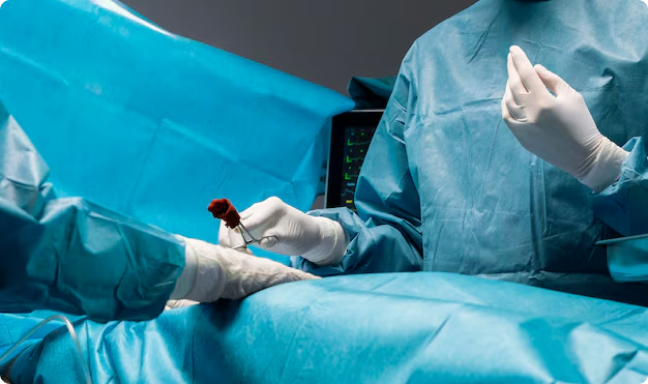Urethroplasty Surgery
Urethroplasty is a surgical procedure designed to repair or reconstruct the urethra, the tube that carries urine from the bladder to the outside of the body. It is primarily performed to address urethral conditions such as strictures (narrowing of the urethra), injuries, or abnormalities that obstruct the normal flow of urine.
During urethroplasty, an incision is made at the site of the narrowed or damaged urethra, the affected tissue is removed, and the urethra is reconstructed to restore its normal size and function. The procedure may involve different surgical techniques, depending on the patient's condition, including excision, tissue grafting, or flap procedures. Urethroplasty is the gold standard for treating complex urethral issues and generally provides excellent long-term outcomes. However, the specifics of the surgery and recovery process can vary, so it's important to consult with a healthcare provider to determine the most suitable treatment.

Who Needs Urethroplasty?
-
Urethral Strictures: Narrowing or blockages of the urethra caused by inflammation, trauma, infection, or previous surgeries.
-
Trauma: Urethroplasty may be necessary after injuries to the urethra from accidents, falls, or medical procedures.
-
Congenital Abnormalities: Some individuals are born with urethral abnormalities that require surgical correction.
-
Failed Previous Urethral Treatments: If other treatments such as urethral dilation or endoscopic procedures have failed, urethroplasty may be the next step.
-
Severe Urinary Symptoms: Difficulty urinating, weak urine stream, frequent urinary tract infections, or urinary retention caused by urethral strictures.
-
Chronic Infections: Repeated urinary tract infections due to urethral issues may require surgery to improve urine flow and reduce infection risks.
Urethroplasty Procedure
The specific details of the procedure will depend on the patient's condition and the surgical approach chosen. Below are the general steps involved in urethroplasty:
-
1. Anesthesia: The procedure is performed under general anesthesia (where the patient is asleep) or local/regional anesthesia (numbing a specific area of the body).
-
2. Incision: The surgeon makes an incision at the site of the urethral issue. The location and size of the incision depend on the individual’s condition.
-
3. Exposure and Evaluation: The surgeon carefully exposes and evaluates the damaged or narrowed portion of the urethra.
-
4. Repair or Reconstruction:
-
Excision and End-to-End Anastomosis: In cases of short strictures, the damaged portion is removed, and the urethra's healthy ends are reconnected.
-
Tissue Grafts: For longer strictures, tissue grafts from other parts of the body may be used to reconstruct the urethra.
-
Flap Procedures: Some complex cases require the creation of a flap from surrounding tissues to reconstruct the urethra.
-
5. Stent or Catheter Placement: A catheter or stent may be inserted to support the urethra and maintain its patency during healing.
-
6. Closure and Dressing: The surgical site is closed with sutures or staples, and the area is dressed. A drain may be placed to remove excess fluid or blood.
-
7. Recovery and Monitoring: After the procedure, the patient is monitored in a recovery area. A short hospital stay is typically required for observation and post-operative care.
Benefits and Risks
Benefits of Urethroplasty:
-
Improved Urinary Function: The primary benefit is restoring or improving urinary flow, relieving symptoms such as difficulty urinating, weak stream, or frequent UTIs.
-
Prevention of Complications: Urethroplasty can prevent complications like recurrent infections, urinary retention, and kidney damage caused by untreated urethral strictures.
-
Enhanced Quality of Life: Successful surgery can improve quality of life by allowing patients to urinate more comfortably and without restrictions.
-
Reduced Dependence on Catheters: For patients who previously relied on catheters, urethroplasty may eliminate the need for long-term catheterization.
Risks of Urethroplasty:
-
Improved Urinary Function: The primary benefit is restoring or improving urinary flow, relieving symptoms such as difficulty urinating, weak stream, or frequent UTIs.
-
Prevention of Complications: Urethroplasty can prevent complications like recurrent infections, urinary retention, and kidney damage caused by untreated urethral strictures.
-
Enhanced Quality of Life: Successful surgery can improve quality of life by allowing patients to urinate more comfortably and without restrictions.
-
Reduced Dependence on Catheters: For patients who previously relied on catheters, urethroplasty may eliminate the need for long-term catheterization.
Risks of Urethroplasty:
-
Infection: As with any surgery, there is a risk of infection at the surgical site or within the urinary tract.
-
Bleeding: Some bleeding may occur during or after surgery.
-
Stricture Recurrence: Although effective in most cases, there is a risk of the stricture returning, requiring further treatment.
-
Urinary Incontinence: Temporary or, rarely, permanent incontinence may occur, especially if the surgery involves the sphincter muscles.
-
Erectile Dysfunction: For surgeries involving the penile urethra, there is a slight risk of erectile dysfunction.
-
Anesthesia Risks: Potential complications include allergic reactions or breathing issues.
-
Scarring and Cosmetic Concerns: Scarring, particularly in the genital region, may occur.
-
Lengthy Recovery: Recovery can be prolonged, with discomfort during the healing process.
-
Functional Outcomes: While the surgery aims to improve urinary function, the level of success varies from patient to patient.
Recovery After Urethroplasty
Post-surgery recovery typically involves some discomfort and swelling, which can be managed with pain medications and ice packs. The length of the hospital stay and catheterization period depends on the complexity of the surgery. Patients should avoid strenuous physical activities and maintain hygiene around the surgical site. Regular follow-ups with the healthcare provider are crucial to monitor progress and address potential complications. Over time, most patients experience significant improvement in urinary function and a better quality of life.
India is home to some of the best urethroplasty specialists who are highly qualified and affiliated with top medical institutions, offering high-quality treatment at affordable rates. Universelle MedicAid is a leader in medical tourism, providing low-cost urethroplasty at world-class hospitals in India. Our partnered hospitals are JCI and NABH accredited, adhering to international standards in urethroplasty procedures.
| Treatment | Cost Start From($) | Hospital Stay |
|---|---|---|
| Urethroplasty Surgery | 1900 - 2300 | 0-1 Days |
| Artificial Urinary Sphincter Surgery (AUS) | 900 - 1500 | 0 - 1 Day |
Frequently Asked Questions(FAQ's)
Important Notes
-
Prices are subject to change without notice.
-
These are indicative prices, which may vary depending on the patient's condition at the time of admission.
-
A final estimate will be provided at the time of the patient's admission.
TREATMENTS
Urology Treatment Surgery

Penile Implant Surgery
Penile implant surgery, also known as penile prosthesis surgery,...
More Information
Erectile Dysfunction Treatment
Erectile Dysfunction (ED) is a common condition affecting many....
More Information
Peyronie's Disease Treatment
Peyronie's disease is a medical condition where fibrous scar tissue...
More Information
Urethroplasty Surgery
Urethroplasty is a surgical procedure designed to repair or reconstruct...
More Information
Artificial Urinary Sphincter Surgery
Urinary incontinence, characterized by the inability to control urine...
More Information
Phalloplasty Surgery
Phalloplasty, also known as phallus reconstruction or penis enlargement...
More Information
Penectomy Surgery
Penectomy surgery involves the partial or total removal of the penis,...
More Information
Priapism Treatment
Priapism is a rare but serious medical condition characterized by a...
More Information
Penile Implant Surgery
Penile implant surgery, also known as penile prosthesis surgery,...
More Information
Erectile Dysfunction Treatment
Erectile Dysfunction (ED) is a common condition affecting many....
More Information
Peyronie's Disease Treatment
Peyronie's disease is a medical condition where fibrous scar tissue...
More Information
Urethroplasty Surgery
Urethroplasty is a surgical procedure designed to repair or reconstruct...
More Information
Artificial Urinary Sphincter Surgery
Urinary incontinence, characterized by the inability to control urine...
More Information
Phalloplasty Surgery
Phalloplasty, also known as phallus reconstruction or penis enlargement...
More Information
Penectomy Surgery
Penectomy surgery involves the partial or total removal of the penis,...
More Information
Priapism Treatment
Priapism is a rare but serious medical condition characterized by a...
More InformationDoctors
Our Specialist Doctors

Dr. Shashank Chaudhary
Surgical Oncology, Cancer Care



Dr. Vijayant Devenraj
Cardiac Surgery (CTVS), Thoracic



Dr. PrasoonKant Shamshery
Orthopaedics & Joint Replacement



Dr. Vikas Singla
Senior Director & Head – Gastroenterology (Pancreatic-Biliary, Luminal Gastroenterology & Endoscopy Division)



Dr. Anita Sethi
Principal Director & HOD - Ophthalmology (Max Panchsheel & Max Saket)



Dr. Anurag Krishna
Chairman - Paediatrics & Paediatric Surgery Paediatric (Ped) Surgery, Paediatric (Ped) Urology



Dr. Bipin Walia
Vice Chairman & Head- Neurosurgery for Max Saket Complex & Vice Chairman- Neurospine, Max Saket



Dr. Dinesh Khullar
Chairman - Nephrology & Renal Transplant Medicine, Max Saket Complex



Dr. H.N. Bajaj
Principal Director (Orthopaedics) & Head (Spine Surgery) Orthopaedics & Joint Replacement, Spine Surgery, Arthroscopy & Sports Injury



Dr. Harit Chaturvedi
Chairman - Max Institute of Cancer Care Cancer Care / Oncology, Thoracic Oncology, Surgical Oncology, Robotic Surgery, Head & Neck Oncology, Breast Cancer



Dr. Kulbhushan Singh Dagar
Principal Director, Chief Surgeon & Head - Neonatal & Congenital Heart Surgery Paediatric (Ped) Cardiac Surgery, Cardiac Sciences, Paediatrics (Ped)



Dr. Pradeep Chowbey
Chairman - Max Institute of Laparoscopic, Endoscopic, Bariatric Surgery & Allied Surgical Specialities



Dr. Sunil Choudhary
Principal Director & Chief of Plastic Surgery (Max Institute of Reconstructive, Aesthetic, Cleft & Craniofacial Surgery (Miracles) Aesthetic And Reconstructive Surgery



Dr. Abhishek Mishra
MBBS, MS - Orthopaedics Orthopedic surgeon, Joint Replacement Surgeon



Dr. Vineet Malhotra
MBBS | MS – General Surgery | DNB – Urology/Genito – Urinary Surgery



Dr. (Lt Col) Ashok Kumar
Senior Consultant & Head - Radiation Oncology



Dr. Aman Jyoti
Senior Consultant – Paediatrics Cardiac Anaesthesia & Cardiac Intensive Care



Dr. Amit Kumar
Associate Director & Head (Unit I) - Interventional Cardiology



Dr. Anushtup De
Senior Consultant & Head (Unit l) - General & Minimally Invasive Surgery



Dr. Arjun Goel
Senior Consultant & Head (Unit II)- General & Minimally Invasive Surgery



Dr. Dinesh Pendharkar
HOD & Director - Medical Oncology, Cancer Care, Haematology & BMT



Dr. Subhash Hakoo
HOD & Director - General & Minimally Invasive Surgery



Dr. Sujoy Bhattacharjee
HOD & Director - Robotic Joint Replacement



Dr. Tanmay Pandya
HOD & Director - Nephrology & Renal Transplantation



Dr. Ved Prakash
Senior Consultant & Head - Cardiothoracic & Vascular Surgery



Dr. Anuj Agrawal
Sr. Consultant Department of Orthopaedics & Joint Replacement



Dr. Ashwini Kumar Singh
Senior Consultant & Head Plastic, Reconstructive & Cosmetic Surgery



Dr. Nikhil Gupta
Orthopaedics, Arthroscopy & Joint Replacement Surgery



Dr. Sparshi Jain
Consultant in Department of Ophthalmology



Dr. (Maj) Ravi Shankar
Consultant - Haemato-Oncology & BMT MBBS, MD (Pediatrics) Fellowship PHO & BMT



Dr. Amrita Tiwary Vyas
Consultant, Neurosciences/Neurosurgery, Brain & Spine Specialist



Dr. Ankit Agrawal
Consultant, Neurosciences/Neurosurgery, Brain & Spine Specialist



Dr. Sudhir Sharma
Director - Minimal Access, Robotic, Bariatric and General Surgery, MBBS, MS, MBA, FIAGES, FICLS



Dr. Sujoy Bhattacharjee
HOD & Director - Robotic Joint Replacement


Book Appointment
Complete the form below to schedule your appointment.
Begin Your Health Treatment Journey with Us
By utilizing our services, you'll find it easier to improve your well-being and feel better."
Consult Now















